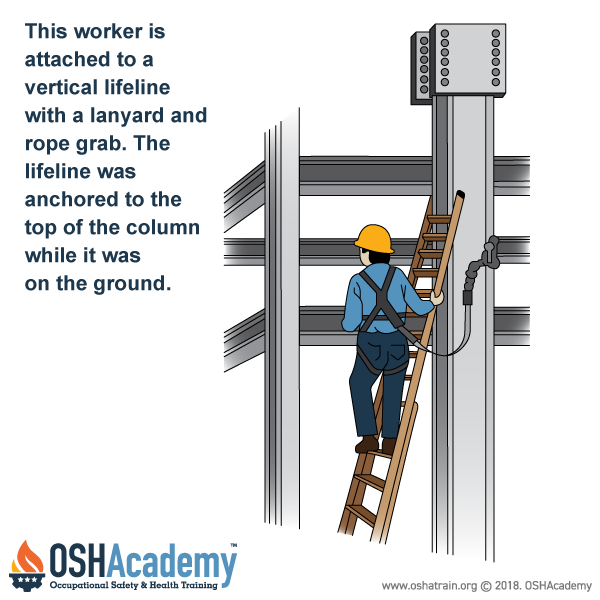Lifelines
A lifeline is a cable or rope that connects to a body harness, lanyard, or deceleration device, and at least one anchorage. There are two types of lifelines: vertical and horizontal.
Vertical lifeline: A vertical lifeline is attached to an overhead anchorage and must be connected directly to a worker's full-body harness, lanyard, retractable device, or rope grab; it must have a minimum breaking strength of 5,000 pounds.
When a worker needs to move horizontally, however; a vertical lifeline can be hazardous due to the potential for a swing fall - the pendulum motion that results when the worker swings back under the anchor point. A swing fall increases a worker's risk of striking an object or a lower level during the pendulum motion.
Horizontal lifeline: Unlike a vertical lifeline, the horizontal lifeline stretches between two anchorages. When you connect a lanyard or rope grab to the horizontal lifeline, you can move about freely, thus reducing the risk of a swing fall. However, horizontal lifelines are subject to much greater loads than vertical lifelines due to what is called "sag angle."
Sag angle is the angle of horizontal lifeline sag when a fall occurs. If the lifeline is tight, it won't sag much when a fall occurs, but the impact force on the lifeline will be higher.
Impact force, as used in this context, is the force or "shock" imparted to a lifeline by the attached lanyard. If the lifeline is not so tight, it will sag more and the impact force on the lifeline will actually be less.
If horizontal lifelines are not installed correctly, they can fail at the anchorage points due to these impact forces. For this reason, horizontal lifelines must be designed, installed, and used under the supervision of a qualified person.
Example: If the sag angle is 15 degrees, the impact force, or force amplification, imparted to the lifeline is only about 2:1. However, when the sag angle is decreased to only 5 degrees, it's tighter, and the impact force imparted to the lifeline increases to about 6:1.
Remember, lifeline anchorages must be strengthened as impact forces increase. To reduce loads on a horizontal lifeline, increase the sag angle or connect to the lifeline with a shock-absorbing lanyard.
Knowledge Check Choose the best answer for the question.
5-10. Which of the following are the two types of lifelines used in personal fall-arrest system (PFAS) design to provide fall protection?
You forgot to answer the question!


